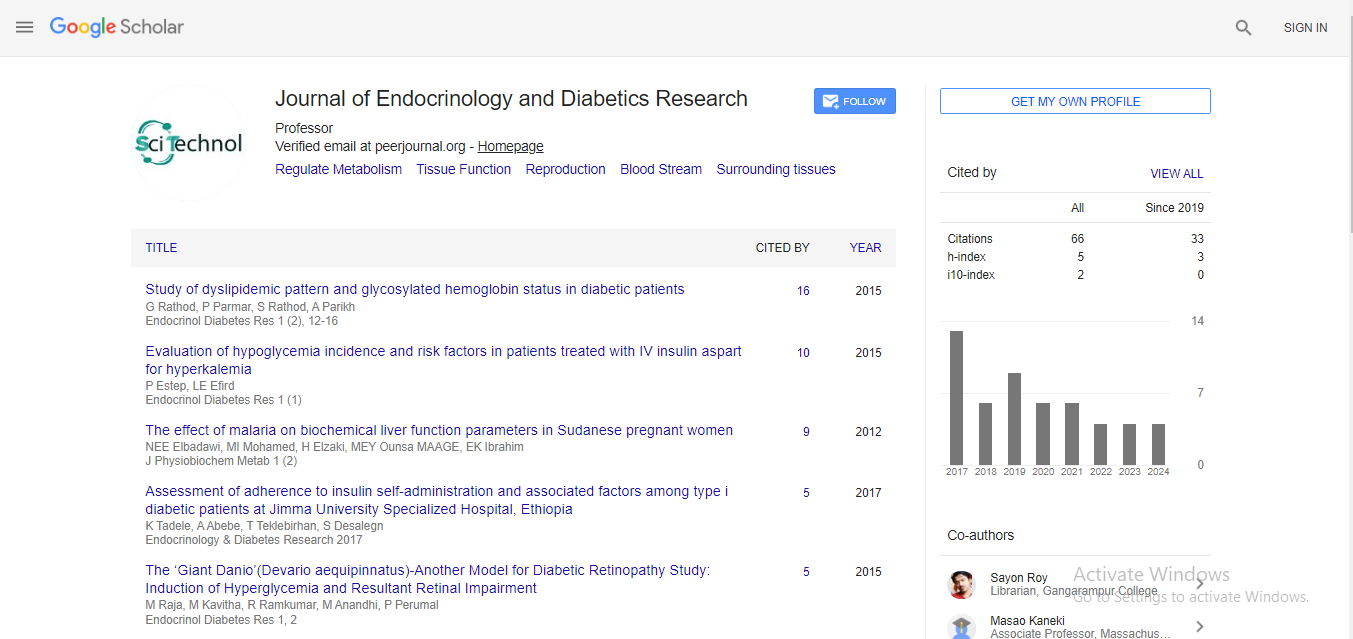Editorial, Endocrinol Diabetes Res Vol: 11 Issue: 1
Gene Expression Profiling: Unlocking the Blueprint of Cellular Function
Fatima Mohamed Ali*
Department of Microbiology, American University in Cairo, Egypt
- *Corresponding Author:
- Fatima Mohamed Ali
Department of Microbiology, American University in Cairo, Egypt
E-mail: fatma354@gmail.com
Received: 01-Feb-2025, Manuscript No. ecdr-25-169197; Editor assigned: 4-Feb-2025, Pre-QC No. ecdr-25-169197 (PQ); Reviewed: 19-Feb-2025, QC No. ecdr-25-169197; Revised: 26-Feb-2025, Manuscript No. ecdr-25-169197 (R); Published: 30-Feb-2025, DOI: 10.4172/2324-8777.1000429
Citation: Fatima MA (2025) Gene Expression Profiling: Unlocking the Blueprint of Cellular Function. Endocrinol Diabetes Res 11:429
Introduction
Gene expression profiling is a powerful molecular biology technique used to measure the activity of thousands of genes simultaneously, providing insights into cellular function, disease mechanisms, and therapeutic targets. By analyzing patterns of gene expression, researchers and clinicians can understand how genes are regulated in different tissues, developmental stages, or pathological conditions. This technology has revolutionized genomics, enabling breakthroughs in cancer research, personalized medicine, drug development, and systems biology [1].
Gene expression profiling is a cutting-edge molecular biology technique that measures the activity of thousands of genes simultaneously within a cell or tissue. By analyzing which genes are “turned on” or “off” in different biological contexts, scientists gain valuable insights into cellular functions, developmental processes, and disease mechanisms. This powerful approach has become essential for understanding the complex regulation of gene activity and its impact on health and disease [2].
At its core, gene expression profiling examines messenger RNA (mRNA) levels, which serve as intermediates between DNA and proteins. Since proteins carry out most cellular functions, measuring mRNA abundance provides a snapshot of cellular behavior and physiological state. Variations in gene expression reflect how cells respond to internal signals or external stimuli, such as environmental changes, disease progression, or therapeutic interventions.
Over the years, several technologies have been developed for gene expression profiling, including microarrays and RNA sequencing (RNA-Seq). Microarrays enable the simultaneous measurement of thousands of known genes, whereas RNA-Seq provides a more comprehensive and sensitive analysis, capable of detecting novel transcripts and alternative splicing events [3].
Gene expression profiling has wide-ranging applications in biomedical research and clinical practice. It is instrumental in classifying diseases, identifying biomarkers, and uncovering molecular pathways involved in cancer, metabolic disorders, neurological diseases, and more. Moreover, it aids drug discovery by revealing potential therapeutic targets and predicting drug responses [4].
In summary, gene expression profiling is a transformative tool that deepens our understanding of biology at the molecular level. By elucidating the dynamic patterns of gene activity, it opens new avenues for diagnosis, prognosis, and personalized medicine, ultimately contributing to improved patient care and treatment outcomes.
Technologies for Gene Expression Profiling
Several technologies have been developed over time to perform gene expression profiling, each with distinct advantages and limitations:
Microarrays
Microarrays were among the first high-throughput tools developed for gene expression profiling. They consist of thousands of DNA probes fixed on a solid surface. mRNA from samples is converted to labeled cDNA and hybridized to the array. Fluorescent signals indicate the abundance of transcripts [5].
Advantages: Cost-effective, relatively simple, well-established protocols.
Limitations: Limited to known gene sequences, lower sensitivity and dynamic range compared to sequencing, cross-hybridization artifacts.
RNA Sequencing (RNA-Seq)
RNA-Seq uses next-generation sequencing (NGS) to directly sequence cDNA derived from RNA transcripts, providing a more comprehensive and quantitative picture of gene expression.
Advantages: Detects novel transcripts, alternative splicing, gene fusions, and single nucleotide variants; high sensitivity and dynamic range [6].
Limitations: Higher cost and data analysis complexity compared to microarrays.
Quantitative PCR (qPCR)
While qPCR is not a high-throughput method like microarrays or RNA-Seq, it remains the gold standard for validating gene expression results by measuring the expression of selected genes with high sensitivity.
Other Emerging Technologies
Technologies like NanoString nCounter and single-cell RNA sequencing (scRNA-Seq) are expanding capabilities by allowing multiplexed expression analysis without amplification biases and enabling profiling at single-cell resolution [7].
Applications of Gene Expression Profiling
Disease Classification and Diagnosis
Gene expression profiling has transformed disease diagnosis, particularly in oncology. For instance, breast cancer subtypes (luminal A, luminal B, HER2-enriched, basal-like) are defined based on gene expression patterns, influencing prognosis and treatment decisions. Commercial assays such as Oncotype DX and MammaPrint assess recurrence risk by profiling panels of genes [8].
Biomarker Discovery
By comparing gene expression between healthy and diseased tissues, researchers identify biomarkers for early diagnosis, disease progression, and therapeutic response. For example, differential expression profiles have revealed biomarkers in diabetes, neurodegenerative diseases, and infectious diseases.
Understanding Molecular Mechanisms
Gene expression profiling provides insights into biological pathways and molecular mechanisms underlying physiological and pathological processes. This helps elucidate gene regulatory networks, cell signaling pathways, and the impact of environmental factors [9].
Drug Development and Toxicology
Pharmaceutical research uses gene expression data to identify drug targets, understand mechanisms of action, and predict toxicity. Gene expression signatures can predict patient responses and adverse effects, paving the way for personalized therapies.
Stem Cell and Developmental Biology
Profiling gene expression during differentiation helps understand lineage commitment and developmental biology, guiding stem cell research and regenerative medicine [10].
Challenges and Limitations
Biological Complexity: Gene expression is dynamic and context-dependent, influenced by cell type, environment, and time.
Data Interpretation: Large datasets require sophisticated computational tools and expertise.
Technical Variability: Differences in sample preparation, platform, and analysis pipelines can affect reproducibility.
Cost and Accessibility: High-throughput technologies, especially RNA-Seq, may be cost-prohibitive for some labs.
Future Perspectives
Emerging trends are shaping the future of gene expression profiling:
Single-Cell Transcriptomics: Analyzing expression at the single-cell level reveals cellular heterogeneity and rare cell populations.
Spatial Transcriptomics: Mapping gene expression within tissue architecture links molecular data with histology.
Multi-Omics Integration: Combining gene expression with genomics, epigenomics, proteomics, and metabolomics provides a holistic view of cellular states.
Artificial Intelligence: Machine learning algorithms improve pattern recognition, biomarker discovery, and predictive modeling.
Conclusion
Gene expression profiling has become an indispensable tool in modern biology and medicine, enabling comprehensive insights into gene function and regulation. By deciphering the transcriptional landscape of cells and tissues, this technology accelerates our understanding of disease mechanisms, enhances diagnostic precision, and guides therapeutic innovation. As methods continue to evolve, especially with the rise of single-cell and spatial transcriptomics, gene expression profiling will play an even more critical role in unraveling biological complexity and advancing personalized medicine.
References
- Reynolds A, Mann J, Cummings J, et al. Carbohydrate quality and human health: a series of systematic reviews and meta-analyses. Lancet. 393: 434-445 (2019).
- Mannucci E, Giaccari A, Gallo M, et al. Self-management in patients with type 2 diabetes: Group-based versus individual education a systematic review with meta-analysis of randomized trails. Nutr Metab Cardiovasc Dis. 32: 330-336(2022).
- O'Gorman DJ, Krook A. Exercise and the treatment of diabetes and obesity. Med Clin N. 95, 953-969 (2011).
- Koutroumpakis E, Jozwik B, Aguilar D et al. (2020) Strategies of Unloading the Failing Heart from Metabolic Stress. Am J Med. 133, 290-296.
- Gregg EW, Li Y, Wang J et al. Changes in diabetes-related complications in the United States, 1990-2010. N Engl J Med. 370, 1514-1523(2011).
- Perkins BA, Ficociello LH, Silva KH et al. Regression of microalbuminuria in type 1 diabetes N Engl J Med. 348, 2285-2293 (2003).
- Warman DJ, Jia H, Kato H et al. The Potential Roles of Probiotics, Resistant Starch, and Resistant Proteins in Ameliorating Inflammation during Aging (Inflammaging). Nutrients. 14, 747 (2022).
- Alicic RZ, Rooney MT. Diabetic kidney disease: challenges, progress, and possibilities. Clin J Am Soc Nephrol.12, 342-356 (2017).
- Johnson VR, Washington TB, Chhabria Shradha et al. Food as Medicine for Obesity Treatment and Management. Clinical Therapeutics. 44, 671-681 (2022).
- Partridge L, Deelen J, Slagboom PE et al. facing up to the global challenges of ageing. Nature. 561, 45-56 (2018).
Indexed at, Google scholar, Crossref
Indexed at, Google scholar, Crossref
Indexed at, Google Scholar, Crossref
Indexed at, Google Scholar, Crossref
Indexed at, Google Scholar, Crossref
Indexed at, Google Scholar, Crossref
Indexed at, Google Scholar, Crossref
Indexed at, Google Scholar, Crossref
 Spanish
Spanish  Chinese
Chinese  Russian
Russian  German
German  French
French  Japanese
Japanese  Portuguese
Portuguese  Hindi
Hindi 


